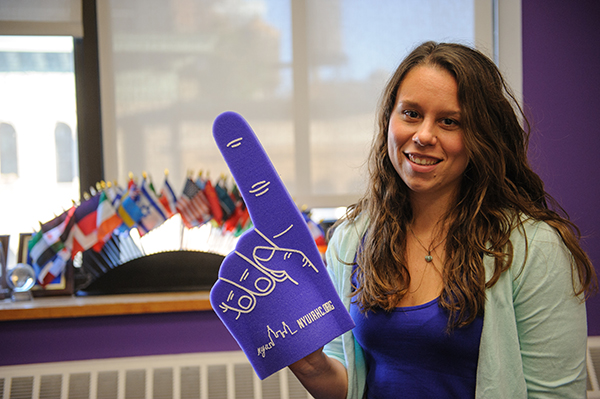 In a cramped classroom at East Side Community High School in Alphabet City, filled with bright signs and posters with phrases like “Keep your hands and objects to yourself” and “Hint: find the area of a trapezoid two different ways,” CAS senior Chelsea Culbert and other mentors walk high school students through Common App questionnaires. This is just another Friday for Culbert, who founded the NYU chapter of the national organization, Strive for College.
In a cramped classroom at East Side Community High School in Alphabet City, filled with bright signs and posters with phrases like “Keep your hands and objects to yourself” and “Hint: find the area of a trapezoid two different ways,” CAS senior Chelsea Culbert and other mentors walk high school students through Common App questionnaires. This is just another Friday for Culbert, who founded the NYU chapter of the national organization, Strive for College.
Culbert lovingly referred to NYU Strive — a program where NYU students mentor low-income high school students on how to apply to college and pay for it — as her “baby.” Serving as the vice president of service in the Inter-Residence Hall Council for her third year in a row, Strive has been one of Culbert’s biggest projects.
After being elected at the end of her freshman year, she began the position and found the duties were vague, the description was basically “docommunity service.” She began organizing the blood drives for each residence hall, as well as the Day of Service and Relay for Life fundraising events in which Culbert, an avid runner, participates.
Culbert started NYU Strive after a representative from the nationwide program sent out a mass email trying to find a way to bring the program to the city. Initially, she worked with one high school, where there were about 30 mentors helping 30 kids. All 30 students were accepted to a college, with the necessary financial aid for four years.
“All of these kids were so eligible to apply to college, but since these high schools only have maybe one counselor for all of the high school, [that person] can’t focus all of [his or her] time on the students and helping them apply to college,” Culbert said.
The program currently works in three high schools around the area, with about 80 NYU mentors aiding 80 students. Culbert decided to create an executive board just to manage the program’s endeavors.
“When we start getting college acceptances, in April and May, that’s just the best time,” Culbert said. “Seeing all these mentees getting their acceptances and being so excited … they didn’t realize they could get into these schools. But they could.”
Although the staff and students at East Side Community High School are receptive to NYU Strive and enjoy the work and benefits of the mentorship program, it is slowly dying out at many other schools.
“[The program] only works if the administration will work with us,” Culbert said, describing how the lack of assistance from can take a toll on the students. “They feel like the school is giving up on them.”
But regardless of what individual schools are doing, NYU Strive has no such plans to give up on New York City high schoolers.
“Since the beginning, Chelsea has been a huge part of Strive, and if I ever had any questions, I’d go to her,” Steinhardt sophomore and student mentor Christina Parthena said. “She really cares for the program and believes in the students.”
But Culbert, constantly busy, also finds other ways to serve her community.
When she is not working with Strive, Culbert works in the lab of assistant professor of biology Esteban Mazzoni to help with his research on amyotrophic lateral sclerosis, also known Lou Gehrig’s Disease, a degenerative illness that affects nerve cells in the brain and spinal cord.
“Chelsea really works toward her goals and is very generous with other students and researchers. We were lucky that her scientific journey crossed with ours,” Mazzoni said. “I was really pleased when she joined our team at NYU.”
Her research consists of growing muscle cells and then putting motor neurons on top of them to see how they interact with one another, eventually creating what is called a “neuromuscular junction.” Soon, the researchers will be able to test drugs on it and use motor neurons infected with ALS.
“I’ve been doing ALS research since high school,” Culbert said. “I was part of an organization that raises money for ALS through my high school because two of our teachers were diagnosed.”
Progress has been slow but steady. Setbacks like Superstorm Sandy complicated the research — their lab became overcrowded by displaced researchers, contaminating their cells. But Culbert experimented with the protocols for turning stem cells into motor neurons and cut the amount of time required for experiments in half.
But regardless of how much shorter the experiments are, Culbert is busy. It still takes about five days to turn stem cells into motor neurons, so each experiment lasts about a week. But with each successful experiment, Culbert, Mazzoni and company gain a slightly better understanding of how ALS works.
Working in dorms, schools and even human cells, Culbert always strives to better the lives of those around her.
— Jonathan Keshishoglou
Studio photography by Alexis Bynum, other images by David Lin/WSN
















































































































































Joseph Larios • May 11, 2016 at 6:08 pm
She’s my teacher!!! She’s awesome and very influential (:
disqus_8XQGszNpeI • Dec 12, 2013 at 2:46 pm
where is Abby Ehrlich on this list????